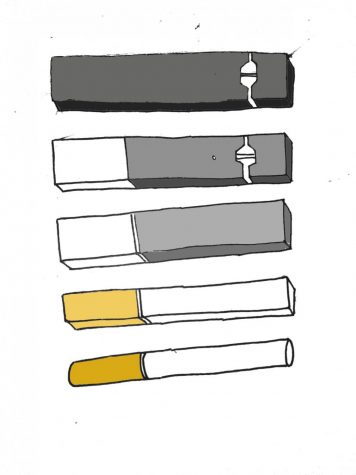Senior “Rachel,” whose name has been changed for anonymity, first used a JUUL her freshman year. One of her friends bought the device and a group of her friends were passing it around. When it was passed to Rachel, she took a puff, unaware of the impact it would have on the rest of her high school experience and beyond. After enjoying that first hit and several more, Rachel bought her own JUUL, granting herself access to the strong sensation of nicotine more frequently.
“I remember the first time I actually used it enough to feel the nicotine. I felt relaxed and kind of fuzzy. That was the first time where I was like ‘woah, that’s cool,’” Rachel said.
Rachel went on to spend roughly the next year as a self-described “addict,” going through a pack of four JUUL pods, which contains nicotine, flavorants and other chemicals, approximately every three weeks. According to Redwood Tobacco Use Prevention Education (TUPE) advisor Jon Hirsch, one JUUL pod is equivalent to 2.5 packs of cigarettes.

“It felt good and I wanted it. I just kept craving it, so I felt the need to keep buying pods,” Rachel said.
A few years later, a combination of parental disapproval, lack of financial resources and desire to increase focus on schoolwork encouraged Rachel to quit vaping. This process was aided by the use of prescribed nicotine patches and nicotine gum, traditionally used to ease the symptoms of withdrawal for smokers attempting to quit. By selling her JUUL, Rachel made it difficult for herself to vape consistently. At first, she experienced symptoms of withdrawal, such as mood spikes and intense cravings, but eventually began to notice a shift in her relationship with vaping.
“I remember being in a car with my friends and watching them use their JUULs and having no desire to hit it and having no cravings for it,” Rachel said.
This feeling was fleeting. Despite her efforts, Rachel was never able to completely quit JUULing. After a month, she stopped using her nicotine patches, which she said irritated her skin and had a tendency to fall off. After this decision, Rachel’s cravings for nicotine resurfaced. Now, Rachel will occasionally hit a JUUL when she is with her friends, but she believes her addiction is much less severe than it previously was.
“I can go days without hitting one and I don’t really care. I don’t necessarily feel as addicted as I did before, but I still enjoy it,” Rachel said.
Rachel’s addiction and subsequent failure to quit vaping is not uncommon. According to the Center for Disease Control and Prevention (CDC), 20.8 percent of high school students used e-cigarettes in 2018. According to Hirsch, the vast majority of confiscated items on campus as of June 2019 were JUULs. Hirsch has the opportunity to provide interventions for students who are found to possess nicotine on campus and receive feedback about their experience at the end of the school year. In an anonymous and confidential survey of the students he has worked with thus far, only 18 percent of daily users reported quitting or reducing their vaping habit by the end of the year while the remaining 82 percent still vape consistently, even with intervention.

JUUL has become increasingly popular since its launch in 2015, leading to a dramatic increase of competitors in the e-cigarette market. Redwood has accordingly increased efforts to prevent the use of e-cigarettes. Yet the consequences of vaping have become apparent as reports of mysterious, vape-related, pulmonary illnesses have dominated this fall’s news feed. As of Oct. 29, 1,888 cases of lung injury and 37 related deaths have been reported to the CDC within the U.S. While cigarette usage causes 480,000 deaths a year according to the CDC, it is unclear what health effects vaping will present in the future. However, these illnesses present the first indicator that the practice may not be safe. According to Health Anthropologist and UCSF Associate professor Jeremiah Mock, these illnesses should not be taken lightly due to new evidence that aerosol produced by vaping is a probable carcinogen.
“Exposing laboratory animals to the aerosol [vapor]… which has droplets and nanoparticles that pass through cell walls… from vaping devices causes them to develop cancer,” Mock said.
Although JUUL’s website states e-cigarettes are intended to aid “adult smokers looking to switch from smoking cigarettes,” the rising reports of pulmonary illnesses are calling a comparison to tobacco products, such as cigarettes, into question. Some, including Hirsch, believe that the illnesses caused by e-cigarette usage are much more severe than lung illnesses caused by smoking. Despite this information, 37.5 percent of students who did not report quitting or reducing their nicotine consumption in an end-of-year survey believe that vaping is “harmful but less [so] than cigarettes,” a drastic understatement according to the TUPE instructor.
“The bottom line is that it’s causing the kind of damage that even cigarettes never caused.

You didn’t see this kind of thing with cigarettes, let alone the cancer that we’re going to start seeing from people vaping and the heart attacks we’re going to start seeing from people vaping,” Hirsch said. “In lab testing, those have been shown to be just as prevalent with vaping as smoking.”
E-cigarettes also seem to have an inverse effect on some teenagers, such as Rachel, who began smoking cigarettes occasionally after attempting to quit vaping.
A common misconception of the new lung illnesses is that the condition can only be caused by vaping Tetrahydrocannabinol (THC), which can be found in products that contain cannabis. However, according to Mock, users of any e-cigarette product should be concerned.
“It’s more likely to be what is called a chemical burn. The chemical burn is from an unidentified chemical or group of chemicals, so the lung tissue is being burned by these chemicals,” Mock said. “There are there are plenty of cases that have been reported where the person who’s come down with anything related to lung injury has not been using products that have THC in them.”
The outbreak of vape-related illnesses show that health repercussions are possible for anyone who has excessively vaped any substance to develop, not just THC. Still, the message has not resonated with students such as Rachel.
“I don’t really care [about the recent reports], mostly because it’s THC stuff,” Rachel said.
As the vape epidemic continues to grow, so does the number of vape-related lung disease patients. This demonstrates the increasing need to prevent the use of any kind of vape to stop the development of more cases.
“We can’t predict the future, but it’s very likely that what we’re seeing now with the cases that are being reported is just the beginning of that tail [of a bell curve] and in the typical distribution of diseases, very often as time goes on, the number of people [affected] over time increases,” Mock said.














